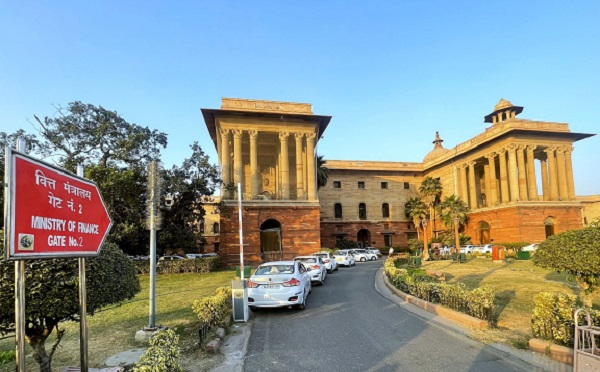.png)

Dhananjay Sinha, CEO and Co-Head of Institutional Equities at Systematix Group, has over 25 years of experience in macroeconomics, strategy, and equity research. A prolific writer, Dhananjay is known for his data-driven views on markets, sectors, and cycles.
November 3, 2025 at 8:50 AM IST
The recent Business Standard BFSI Insight Summit offered valuable insights into the mindset of India’s policy establishment amid intensifying global trade fragmentation. Key contributions came from Chief Economic Advisor V. Anantha Nageswaran.
Speakers unanimously affirmed India’s solid growth performance of 6.5–7.0% despite receding global impulses. They attributed this to a balanced policy mix of fiscal consolidation, monetary policy, and structural reforms, including tax simplification, GST revisions, and emphasis on infrastructure and digital public goods. Much of the credit, they argued, lies in keeping inflation within target and maintaining currency stability; the CEA even suggested the rupee could appreciate.
Yet, amid this optimism, the persistent lack of private capex revival, despite resolving the decade-old twin balance sheet problem of leveraged corporates and bank NPAs, remains unexplained. Responses ranged from portraying the shift from fiscal capex to demand-supporting measures as a natural progression toward private investment to expressions of helplessness beyond the mantra of “ease of doing business.” The familiar argument that rising capacity utilisation and demand will soon trigger private hunger for expansion has grown stale and unconvincing.
This explanatory vacuum has persisted for over a decade, spanning at least three CEAs and multiple RBI governors. It exposes the Achilles’ heel of the official narrative: its detachment from ground realities of declining broad-based productivity, rising disguised unemployment, ruralisation, and depressed real incomes, consumption, and household savings.
Notwithstanding recent GDP prints, the CEA acknowledged structural challenges to India’s growth outlook. He outlined a forward-looking blueprint for an era of tectonic geopolitical and structural shifts that could endure another 25 years, advocating “indigenous invulnerability” and “strategic indispensability” as imperatives.
Private Capex
The most perplexing aspect of India’s policymaking over the past 12 years has been the vacillation on reviving private investment. Initial diagnoses blamed policy paralysis; subsequent fixes included twin balance sheet resolution, corporate tax cuts, public infrastructure spending to crowd in private capex, and now a focus on demand revival. Official prescriptions have traversed a labyrinth of trial and error.
The CEA now argues that private capex has been hampered less by high borrowing costs than by weak demand. Restoring household confidence and purchasing power, he contends, matters more than interest rate tweaks. This overturns earlier advocacy for rate cuts to spur investment and undermines the case for monetary easing to boost household demand.
Tax cuts, he suggests, now serve a dual role: stimulating consumption while enhancing productivity. Yet this hypothesis fails to explain why massive public-led capex in infrastructure, digitalisation, and formalisation, coupled with combined government debt nearly doubling to ₹300 trillion over seven years, has not crowded in private investment. It is unconvincing that modest tax stimuli (less than 0.5% of GDP from GST rationalisation and income tax easing) will succeed where supply-side pushes failed, especially amid trade fragmentation projected to intensify over the next 25 years, building on protectionism already evident for a decade.
Behavioural Impediments
His observation that banks face competition from financialisation of savings, and risks to conventional lending, implies persistent slack in term loans tied to private capex.
Inflation, Currency, and Financial Stability
Emerging market currencies like the rupee respond more to growth differentials than to inflation, rates, or external deficits. Narrowing inflation gaps alongside slowing de facto growth and capex appetite has reduced foreign capital inflows, with the foreign investment/GDP ratio at a 25-year low. This underscores the pro-cyclical nature of capital flows and currency performance.
Structural Weaknesses
These risks undermine the demand revival India seeks. Manufacturing-led job creation is recognised as urgent to broaden productive incomes and social resilience, yet the CEA offered no explanation for manufacturing GVA falling to a historical low 13.8% in 2024–25, despite macro-prudential accolades.
Self-Reliance
“Strategic indispensability” envisions India as an irreplaceable supply-chain node, akin to China’s manufacturing leverage. The prerequisite is “indigenous invulnerability”, self-reliant strength sustaining growth amid disrupted trade and capital flows.
These goals echo prior initiatives: Make in India (2014, targeting 25% manufacturing/GDP), Atmanirbhar Bharat (2020, reducing import dependency via Vocal for Local and export leadership), Production-Linked Incentives (2020–25, 14 sectors), defence import substitution, Gati Shakti, and Ease of Doing Business 2.0.
Historically, India achieved invulnerability in sectors via Nehruvian PSU-led industrialisation, the Green Revolution (1950s–1970s), White Revolution (1970s), and dominance in textiles, iron & steel, leather, auto parts, and pharmaceuticals. Services exports, via ITES and GCCs, exemplify indispensability.
Yet manufacturing’s national and global share has hit historic lows. Large firms’ dominance is at a peak, but manufacturing and formal-sector employment shares are declining. Capital deepening has widened the profit–labour compensation gap; the CEA urges equitable productivity gains to foster inclusion.
Policy Overhaul
De-globalisation demands greater seriousness than post-2012 protectionism. Mere rehashing of import substitution and self-reliance may not suit fragmentation, given high public debt limiting fiscal incentives and demographic pressures from falling productivity.
First, overhaul data quality: researchers (e.g., Arvind Subramanian, 2017) and others highlight overstated GDP and understated unemployment (via PLFS inclusion of disguised workers since 2018).
Rather than centralised policies, grant state and local autonomy within a national framework to spur enterprise and tackle unemployment. The CEA’s China-inspired model overlooks how provincial governments drove growth there. Chinese wage suppression aided local manufacturing, but India’s productivity gains accrue to oligarchs, squeezing smaller firms.
A bottom-up approach has precedents: South India’s rise (e.g., Tamil Nadu, Kerala) stems from early prioritisation of education, health, and population control, yielding skilled labour for manufacturing and services. Tamil Nadu’s Dravidian governance since 1967 blended stability with industrial planning, diversifying into automobiles, textiles, IT, and electronics, creating entrepreneurship beyond national champions. This virtuous cycle has widened the North–South development gap.
India’s policy bias toward manufacturing capex mimics an outdated China model (de-emphasised since 2014). Instead, prioritise services investments. Household consumption now tilts toward services (50% of PCE), with durables/semi-durables at 10%. Labour-intensive services, health, transport, logistics, education, tourism, offer superior employment, income, and demand potential. Protectionism via duties or subsidies favours large firms, unlike the broad-based buoyancy of 1990–2012.
Global trade’s decoupling from growth since 2012 mirrors economic lethargy, inequality, falling savings, and rising indebtedness. India’s lower foreign-capital reliance aids external stability but signals subdued domestic formation. Optimism that emerging markets like India will escape escalating barriers is misplaced. Suppressed demand and labour underutilisation risk demographic constraints. Crisis absence may mask stagnation.
India’s policy response to global fragmentation must transcend recycled slogans of self-reliance and manufacturing revival, confronting instead the entrenched paradoxes of macro stability without micro dynamism. True strategic indispensability demands a decentralised, services-oriented framework that harnesses regional strengths, restores trust across stakeholders, and prioritises broad-based productivity gains over oligarchic concentration. Only by grounding ambition in granular realities, overhauled data, equitable incomes, and labour-absorbing growth, can India transform vulnerability into enduring resilience amid a fractured world.




